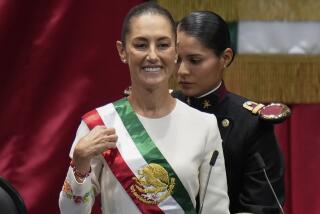Touchy Times in Peru
- Share via
At 36, Alan Garcia Perez will be one of the world’s youngest heads of state when he is inaugurated this weekend as the president of Peru. With that distinction will come some of the world’s most difficult political challenges.
Foremost is a Peruvian economy in severe recession. The downturn has hurt both the average citizen (inflation reached an annual level of 200% recently) and the Peruvian government’s standing in the world financial system (Peru is already $500 million in arrears on the payment of its $14-billion debt).
Garcia is the first Peruvian president from the APRA party, a vaguely socialistic but also fiercely nationalistic organization founded in the 1920s. Some analysts have looked to past APRA policy statements for a clue to Garcia’s plans, noting that they emphasize protectionism for national industry and investment in the country’s rural areas with the aim of alleviating poverty and making Peru self-sufficient in food products.
Other analysts look to the statements that Garcia has made since election day, criticizing the International Monetary Fund and other world financial organizations that have tried to pressure Peru to cut government spending until the economy has recovered. They conclude that Garcia will be troublesome in the short run--refusing to pay Peru’s debt until it is renegotiated, for example--but they hope that he will eventually come around to accept traditional economic remedies, as Argentine President Raul Alfonsin recently did.
But if Garcia is to impose fiscal austerity he will have to deal first with another major problem facing Peru--spreading social unrest. There is a serious crime problem in Peru’s major cities. There are also many labor disputes as union members protest wages that do not keep pace with inflation. And in Peru’s Andean highlands an insurgency led by some of the most radical and violent guerrillas in Latin America, a mysterious group called Sendero Luminoso, continues unabated amid troubling signs that it may be spreading from the Ayacucho region, where it began, to other areas in which Peru’s Indians live in squalor and cultural isolation.
As is often the case in Latin America, the danger of such unrest is not just the possibility of an explosion into all-out rebellion but an equal chance that it could prompt the nation’s security forces to seize power to protect national security. The last coup in Peru occurred in 1968, and the military did not surrender authority to civilian leaders again until 1980. There have been reports that some Peruvian officers are again restive, especially those who remember the APRA party’s early days as an opposition faction, when it resorted to occasional violence as a means of protest. Garcia has calmed their concerns with campaign pledges to come down hard on violent dissidents, particularly Sendero Luminoso. But he must be careful that any crackdown that he permits is not so brutal and widespread that it radicalizes Peru’s peasant population.
So Garcia is in a most difficult position for a young political leader. At a time when he would normally be tempted to exercise his new power in innovative ways, he will instead have to tread cautiously, being careful of the Peruvian military, of his country’s unions and peasant groups, and of the international banks. They should all give Garcia the time that he needs, for his inauguration may well mark the start of Peru’s last opportunity to deal with its many problems without the widespread violence that plagues other Latin American countries.
More to Read
Sign up for Essential California
The most important California stories and recommendations in your inbox every morning.
You may occasionally receive promotional content from the Los Angeles Times.










